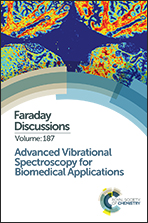Advancements in quantum cascade laser-based infrared microscopy of aqueous media
Abstract
The large mid-infrared absorption coefficient of water frequently hampers the rapid, label-free infrared microscopy of biological objects in their natural aqueous environment. However, the high spectral power density of quantum cascade lasers is shifting this limitation such that mid-infrared absorbance images can be acquired in situ within signal-to-noise ratios of up to 100. Even at sample thicknesses well above 50 μm, signal-to-noise ratios above 10 are readily achieved. The quantum cascade laser-based microspectroscopy of aqueous media is exemplified by imaging an aqueous yeast solution and quantifying glucose consumption, ethanol generation as well as the production of carbon dioxide gas during fermentation.
- This article is part of the themed collection: Advanced Vibrational Spectroscopy for Biomedical Applications

 Please wait while we load your content...
Please wait while we load your content...